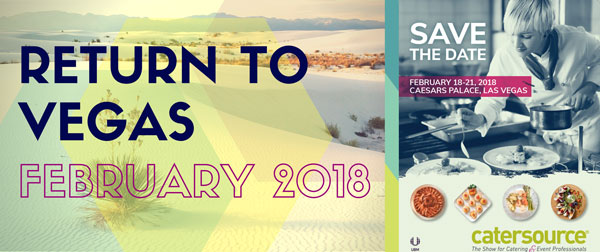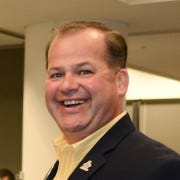A Radical Thought on Menu ProductionA Radical Thought on Menu Production
A Radical Thought on Menu Production

This system may not be for all of you, but for those of you decide to dive in and give it a solid try—I promise you—you can add 5% to 15% profit to your bottom line immediately. It's scary, it takes commitment, it takes an informed sales team that is brought into the process, but most of all takes precise planning and exact execution.
Let me also tell you how this idea came to fruition. In December we do double the volume of any other month. It goes without saying, too, that in December we make more money than any other month. One day I was thinking: why do we do so well in December?
What I kept coming back to was that as a company, we knew that in December we were going to do 45 to 65 parties no matter what. If my small company was going to keep up with that, we needed a plan. And the plan is, quite simply, that everybody is going to eat the same food.
We don't cater during Thanksgiving so we took the entire week before Thanksgiving and did what we call mass production. We brought in the dishwashers, cooks, and the secretaries in and we produced multiple hors d'oeuvres, put them in the freezer, and pulled them as we needed them. Below is what it turned into.

The six-month cycle
The idea is to run one menu in a six-month cycle and go with it. (This is our hors d’oeurve menu—not our buffet menu—but 90% of our parties are hors d’oeuvres only.) I also offer about 10 action stations.
My two cycles are April to September and September to February. During that time I offer one hors d'oeuvre menu and one only. My hors d'oeuvre menu consists of 10 items. Additionally, 70% of those menu items can be frozen. What I do is this: 30 days before we open a new menu cycle I set aside three to five days of intense kitchen prep. Simply said, I produce seven items—70% of my menu—in quantities of 2,000 to 4,000 each. I freeze them in a blast freezer in groups of 50 to 100 depending on the hors d'oeuvre, and then put them in a separate party freezer. (Good packaging is important—we also label the outside of the freezers with contents.)
Then, for the next few months, we pull packs of frozen hors d’oeuvre as we need them. This means we have to prepare no more than three fresh items for a party.
My business—and I—run on forms, and these hors d’oeuvre menus are no exception. Forms for the menu include:
• Buy list for Menu A. This is my ordering sheet. What do we need to purchase to prepare Menu A?
• Production schedule for Menu A, which includes product, quantity prepared, chef to prepare, special notes, tray or vessel for service.
• Packing list for Menu A that is complete, except for the quantities. For example, the packing list will list pates, but we won’t fill out the number on the list until we know how many will be at the party.
• Table layout. I take Menu A and make a standard table layout for it. This may vary a bit depending upon the tables you are using, but the concept should be consistent.
• Ten first things to do. This is the list of the first 10 things my chefs need to do to prepare that specific menu once they get on site. Some things may vary depending upon the equipment they need when they get to the party (such as, does the location have a stove? A refrigerator?) But this list helps my chefs focus on how they will need to prep, prepare, and serve at the site. This list includes specific instructions on plating, cooking tips, holding tolerances, garnishing, and which trays to use.
"With a standard menu, this allows [my team] to do the same job every time and to really know that job. This has allowed me to arrive at parties later, to have quicker set up times, and even to pre-pack for parties in advance, without knowing the exact guest count."
Implementation
At the beginning of any week during the menu cycle, the chefs go to the freezer and pulls foods for parties that week. They label everything with the party name and put them in the appropriate section of the freezer or refrigerator. Then they knock out the fresh items, sauces, garnishes, and anything else that is added to the menu. Yes, sometimes things are added to the menu, but we are so far ahead of the curve because of our advance prep that we can make changes easily.
I take this concept of pre-planning even further: I form catering teams and try to send the same team to each party. With a standard menu, this allows them to do the same job every time and to really know that job. This has allowed me to arrive at parties later, to have quicker set up times, and even to pre-pack for parties in advance, without knowing the exact guest count. I have eliminated huge chunks of overtime during peak periods by standardizing the menu and the work this way. Two chefs can prep 15 to 20 parties a week–and I am talking about good food, not franks and beans.
I believe in progressive cooking at an event—that is, taking food out as it is needed to cook or thaw, rather than taking it out all at once. If we don’t use all of the foo at one party, we can bring it back and use it at the next party, without compromising quality.
My radical menu concept has allowed me to handle much greater volume—and that’s just good business.

Interested in learning more? This article is an excerpt from Perfect Fit: Enjoy the Journey, Love the Food, available here. Bill Pannhoff is the senior event planner for B&B Catering & Event Planning and head ambassador for Catersource Conference & Tradeshow, and just presented his 100th session at Catersource 2017 in New Orleans.








